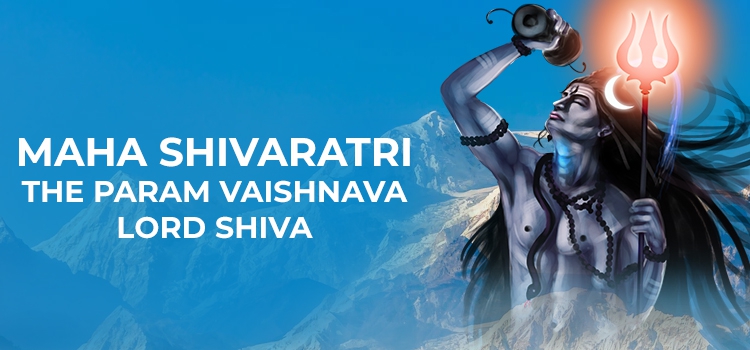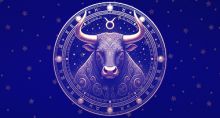Maha Shivaratri - The Param Vaishnava Lord Shiva
The word ‘Shivratri’ means the ‘night of Shiva’. It is celebrated every month on Krishna Chaturdasi, but in Phalguna month (Feb-Mar), it is called Maha Shivratri, which means ‘the great night of Shiva’. This is an important day for devotees of Shiva, who undertake a strict fast and perform meditation and night-long vigil to connect with the deity.
Significance of Maha Shivaratri
This day is significant for many reasons. It is the day when he performs the cosmic dance of Tandava to destroy the universe. It was also on this day that he married Goddess Parvati. Yet another legend says that Shiva drank the halahala poison, which emerged during Samudra Manthan on this day, to save the universe from destruction. This is why the festival is known as Maha Shivratri and Jal Ratri.

Importance of Shiva
Lord Shiva is the one who controls the material world. He has many names, like Shambu, Shankar, Mahesh, Mahadeva, and Rudra.
There are 4 tattvas (principles) in this world that are quite hard to grasp. They are Guru Tattva, Radha Tattva, Dham Tattva, and Shiva Tattva. Our intelligence and efforts cannot suffice to comprehend them, so we need to look to the Shastras.
The Brahma Samhita, Chapter 5, Text 45, says:
ksiram yatha dadhi vikara-visesa-yogat
sanjayate na hi tatah prthag asti hetoh
yah sambhutam api tatha samupaiti karyad
govindam adi-purusam tam aham bhajami
Meaning - ‘Just as milk is transformed into curd by the action of acids, but yet the effect curd is neither same as, nor different from, its cause, milk, so I adore the primeval Lord Govinda of whom the state of Shambhu is a transformation for the performance of the work of destruction.’
This essentially means that Shiva, as well as Brahma and Vishnu, has a role to play in maintaining the balance in the world. Also, Brahma, Vishnu, and Shiva, through Rajo, Sattva, Tamo, and Guna, ensure the proper arrangement of the world. Vishnu and Shiva are above the Gunas. It is under their supervision that the universe is created and destroyed. Hence, they are called Guna Avatars.
Some believe that Shiva is affected by Tamo Guna. But this is not true. Shiva is the presiding deity for the Tamo Guna. Demons, ghosts, evil spirits, the ignorant- all come under his care.
Are Shiva and Vishnu the Same?
The Anusashan Parva of Mahabharata, the Shasatra (1000 names of Vishnu), Shiva, Rudra Sthanu signifies that both are the same.
Several Shastras state that there is no difference between the two deities. But if we examine them closely, there actually is a difference.
The meaning given below is by Chaitanya Mahaprabhu, who formulated the philosophy of Achintya-Bheda-Abheda (simultaneous oneness and difference). This philosophy argues that that God is simultaneously "one with and different from His creation".
Canto 12 of Srimad Bhagavatam mentions that it is the essence of all Vedic literature. It also says that amongst all Vaishnavas, Shiva is foremost: ‘Vaishnava Nam Yatha Shambhu.’
In Canto 4, Shiva says that those who recite the Rudra Geet Stotra can attain the lotus feet of Krishna easily.
Among the 4 Vaishnava Sampradayas, Shiva himself initiated the Rudra Sampradaya. The most prominent Acharya in this Sampradaya is Vishnu Swami, who shows the path toward Krishna Bhakti.
In the Shiva Purana, Shiva says, ‘Sri Rama Rama Rameti Rame Rame Manorame Sahasranama Tattulyam Rama Nama Varanane’ while instructing Parvati. (Meaning: I perpetually take the name of Sri Ram, and in the name of Ram, I forever lose myself. Thus, chanting Rama’s name even once is like saying Vishnu Sahasranamam a thousand times.
In this manner, we learn from the Shastras that no distinction exists between Vishnu and Shiva. Shiva, in fact, considers Vishnu to be his Aradhya- deva.
Krishna and Shiva’s Loving Exchange
In Canto 8 of Srimad Bhagavatam, at Shiva’s request, Vishnu gives him darshan of his Mohini avatar. Using his Yogamaya, Vishnu made Shiva feel attracted to Mohini and perplexed him. This loving exchange between them has often been mistaken as a contest to see who’s supreme.
To take part in Krishna’s Raasa Lila, Shiva became a gopi. Even now, devotees worship him as Gopeshwar Mahadeva. His shringar or decoration is also done in the form of a gopi.
Shiva Protects the Dham
Shiva, as Kshetra Palaka, protects the Dham everywhere. In Mathura, he is Bhooteshwar Mahadeva, Manasi Ganga, and Goverdhan Jangleshwar Mahadev. In Nandgaon, he is Nandeshwar Mahadev, and in Kamya Van, he is Kameshwar Mahadev. In Vrindavan Dham, the Digpal is Gopeshwar Mahadeva.
Sridham Vrindavan has immense importance for Gaudiya Vaishnavas. In many Gaudiya literary texts, Acharyas have sung the praises of Gopeshwar Mahadeva. Also, Narahari Chakravarti, in his work, Bhakti-Ratnakar, says, “I offer all my obeisances to Gopeshwar Mahadeva who destroys all obstacles coming on the path of Bhakti and help attain Bhagvat Prema in Vrindavan”.
When Shiva came to know that Krishna was in Vraja, at Nanda’s house, he came to see him. Krishna was in the form of a baby, performing his lilas, lying on the lap of Yashoda. Lord Shiva appeared before Yashoda in his natural form, with three eyes and long, unkempt hair. He was wearing tiger skin, a garland of snakes, a belt of scorpions, and had ashes smeared all over his body.
Yashoda, who always treated visiting saints generously, told him to wait outside and said that she would give him a gift.
But Shiva replied, “ I don’t want any gifts. I came here to see your son.”
On hearing this, Yashoda replied, “You can’t see him. Take what I give and leave before your snakes and scorpions fall here. My baby is very small, and he will be frightened by your attire.” But Shiva said, “I won’t go until I see your son.”
But, as Yashoda refused to relent, Shiva thought, “O Krishna! You rule the universe, but you are hiding in the house of this cowherd lady. This is your will. If you do not wish to see me, what can I do?”
Realizing that Shiva, his best devotee, had gone away unsatisfied, Krishna began to cry. The gopas and gopis tried to stop his crying but failed. He went on crying loudly. Finally, a gopi, Lalita, asked Yashoda if anyone had left the house disappointed. She pointed out that a Sadhu should never leave a person’s house unsatisfied. He should have been given what he wanted. Because of it, a curse had fallen on Krishna and all the others. She wanted Yashoda to call the Sadhu back.
Yashoda described the Sadhu’s appearance to Lalita. Lalita went in search of him and found him. She also brought him back to the house. On seeing him, Yashoda gave him the infant Krishna who was still crying.
The moment Shiva took Krishna he stopped crying and smiled at Shiva, his pure devotee.
Seeing this, Yashoda requested Shiva to stay there. So he went on to live there as Nandeshwar Mahadev. No one can enter the Dham without his permission.
How to Observe Maha Shivratri
Krishna, in the Bhagavad-Gita, says that from the highest planet to the lowest, all are realms of misery where birth and death happen repeatedly. But those who attain his abode will never have to take birth again.
Shiva has a Japa mala in his hand all the time, and he is always taking the holy names of Rama or Krishna.
In the Padma Purana, Shiva says that though there are many types of worship, the best is the worship of Vishnu or Krishna. He also adds that better than the worship of Krishna is the worship of his devotees.
Krishna illustrated this when Sage Narada came to see him in Dwaraka. He arose from his throne to greet him and also washed the feet of his ardent devotee, and also accepted the water on his head.
In the Bhagawatam, when Shiva was asked about the true goal of life and how to achieve it, he replied that one should take the name of Hari. Hence, Shiva always serves Vishnu in all his different forms. For instance, he served Rama as Rudra (Hanuman).
Maha Shivaratri 2023 is on 18 February.



















